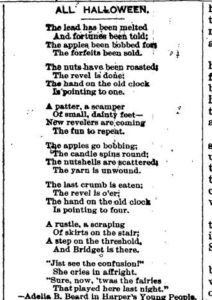More Trick Than Treat: Halloween in 19th Century Geneva
By Amy Pepe, Visitor Services Manager and Public Programs Manager at Rose Hill Mansion and Johnston House
Halloween, or All Hallows Eve, has been celebrated in some form or another in America since the 18th century. However, observance of the holiday has changed drastically. Today’s customs of dressing up in costumes and going door to door asking for candy were not popularized until the 20th century.
The first celebrations of Halloween in America were in the southern colonies to celebrate the harvest and included “play parties” where guests told ghost stories, read fortunes, danced, sang, and played pranks. It wasn’t until the latter half of the 19th century that Halloween became more widespread in America, in part due to in the influx of millions of Irish immigrants who brought traditions rooted in the Celtic celebration of Samhain.
By at least the 1870s, Halloween is mentioned in Geneva newspapers. Newspapers most frequently reported on the “mischief making” that seems to have occurred every year. This typically included harmless pranks such as “pulling door bells, carrying off gates, breaking windows and throwing cabbage stumps and beans.” In most cases it seems that young men were responsible for the deeds and the newspapers generally took the attitude that these were “kindred pranks performed in a spirit of innocent fun.”
However, not everyone took such a lighthearted view of the Halloween mischief. In response to the pranks, one local resident suggested that “If a few of these lawless youths could be summarily punished for their lawless actions…it would have a most salutary effect on their future conduct.” Indeed, these pranks sometimes escalated into more serious crimes such as property damage, some of which led to arrests. In 1898, five lodgers were told to “get out of Geneva as soon as possible” for destroying a sidewalk on Halloween night. Sadly, there was at least one death that resulted from Halloween pranks in nearby Lyons. In 1899 “Louis Doane, of Lyons, was thrown into convulsions Halloween night by a party of young people, who rigged up one of their number as a ghost, scaring Mr. Doane so badly that he was recently seized with convulsions, which ultimately resulted in his death.”
Aside from these mischievous deeds, there were other ways people celebrated Halloween locally. At least one year a “Halloween Social” where clam chowder was served was held at the First Baptist Church. In 1899 a ghost party was held at the home of Mrs. M. H. Ives on Castle Street where “men and women clothed themselves in unearthly garb,” some of which “were decorated, others were plain, all were creepy.”
Local newspapers printed ghost stories as well as ideas for games and tricks that could be played on Halloween. One article reminds readers that “tradition says the love-sick maid may read her fate in the mirror tonight.” Another explains the basics of playing a game of “clairvoyance” where one party guest plays the role of a medium and attempts to guess words other guests are thinking of.
By the turn of the 20th century, there was a cultural shift in American away from the “mischief making” at Halloween and family friendly activities became more popular. It wasn’t until the 1930’s that Trick-or-Treating as we know it today came into fashion.
Sources:
- Newspaper articles drawn from: Geneva Daily Times, Geneva Daily Gazette, Geneva Advertiser.
- Rogers, Nicholas. Halloween: From Pagan Ritual to Party Night. New York: Oxford Univ. Press, 2002.
- “ History of Halloween,” History Channel.


